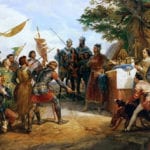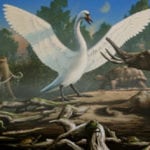 Weird Stuff
Weird Stuff  Weird Stuff
Weird Stuff  Mysteries
Mysteries 10 Tragic Disappearances and Deaths in Joshua Tree National Park
 History
History 10 Ways Childhood Really Sucked in the Old West
 Music
Music 10 Name Origins of Famous Bands from the 1990s
 Religion
Religion 10 Biggest Turnarounds by the Catholic Church
 Weird Stuff
Weird Stuff 10 Unbelievable Times Laws Had Unintended Consequences
 Humans
Humans Ten Historic Women Who Deserve Way More Credit Than They Got
 Movies and TV
Movies and TV 10 Films That Spawned Major Lawsuits
 History
History Ten Times Towns Were Wiped Off the Face of the Earth
 Creepy
Creepy 10 of the Most Disturbingly Haunted Public Houses in the UK
 Weird Stuff
Weird Stuff 10 Niche Subcultures That Are More Popular Than You Might Think
 Mysteries
Mysteries 10 Tragic Disappearances and Deaths in Joshua Tree National Park
 History
History 10 Ways Childhood Really Sucked in the Old West
Who's Behind Listverse?

Jamie Frater
Head Editor
Jamie founded Listverse due to an insatiable desire to share fascinating, obscure, and bizarre facts. He has been a guest speaker on numerous national radio and television stations and is a five time published author.
More About Us Music
Music 10 Name Origins of Famous Bands from the 1990s
 Religion
Religion 10 Biggest Turnarounds by the Catholic Church
 Weird Stuff
Weird Stuff 10 Unbelievable Times Laws Had Unintended Consequences
 Humans
Humans Ten Historic Women Who Deserve Way More Credit Than They Got
 Movies and TV
Movies and TV 10 Films That Spawned Major Lawsuits
 History
History Ten Times Towns Were Wiped Off the Face of the Earth
 Creepy
Creepy 10 of the Most Disturbingly Haunted Public Houses in the UK
10 Animals with Awesome Military Careers
Military life is all about discipline and uniform behavior, so it can be difficult to stand out. Still, there are people who are able to rise through the buzz-cut masses and create a career path that is truly the stuff of legends.
And sometimes, these extraordinary people . . . aren’t even people.
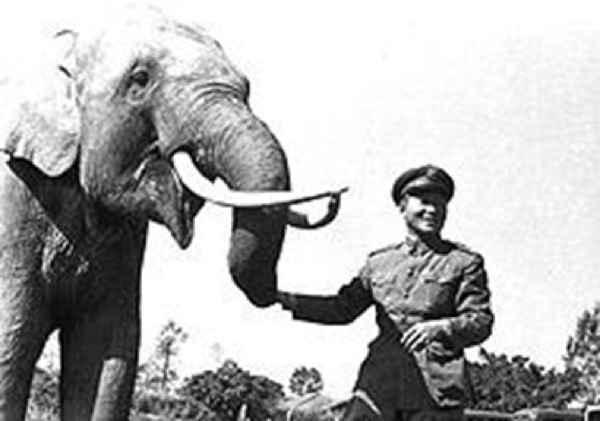 Lin Wang was not a typical World War Two veteran. He fought for both the Japanese and Chinese sides of the Second Sino-Japanese War (the China versus Japan part of WWII). Also, he was an elephant.
Lin Wang was not a typical World War Two veteran. He fought for both the Japanese and Chinese sides of the Second Sino-Japanese War (the China versus Japan part of WWII). Also, he was an elephant.
Strangely, Lin Wang’s original name was Ah Mei, “The Beautiful.” The massive bull elephant pulled artillery cannons for the Japanese army in the thick jungles of Burma, until his unit was defeated by the Chinese troops in 1943. He continued his army service under Chinese command until the end of the war. Eventually, he was relocated to Taiwan, where he served as obstacle-moving muscle in a military base.
Lin Wang also managed what so few war veterans achieve: a happy ending. The Chinese army released him from duty in 1952 and he found a new home in a Taiwanese zoo. There, he received his new, manlier name (Lin Wang means “King of the Forest”) and met a lady elephant who became his lifelong mate. Lin Wang went on to become the most famous animal in all Taiwan, and the longest-living captive member of his species. When he died in 2003, he was 86. The country mourned him with traditional funeral rituals as though he were a human being, lighting incense and burning paper money in his honor.
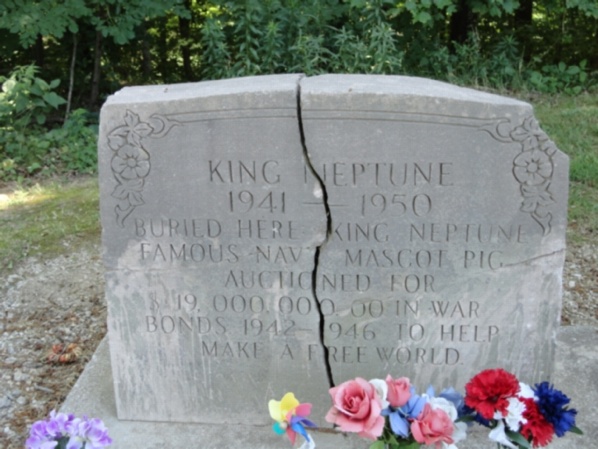
“Roadside attractions” are peculiar museums and sights littered all over the American road network. Among these strange locations lies the memorial stone of King Neptune, the only “royal” member of the US Navy.
King Neptune‘s original job was to attend a WWII fundraiser roast dinner . . . as the roast dinner. Luckily, Neptune happened to be a particularly handsome pig, so a local recruiter decided to try another approach. Instead of the dinner, Neptune became the show. He was ceremoniously presented to the public, who could buy parts of him (such as bristles and squeals) as they were jokingly auctioned for war bonds.
The photogenic pig was an instant hit. Soon, appearances by King Neptune were in high demand. His shows became more and more elaborate. He started wearing silver earrings and a golden crown to suit his regal moniker. Since Neptune was a Hereford swine, his natural colors were red and white. His handlers started covering him with a blue Navy blanket to complete his All-American look.
Neptune’s efforts raised an unbelievable US$19 million (over $250 million, adjusted for inflation) in war bonds, most of which went towards the construction of the battleship USS Illinois. The pig was hailed a hero and allowed to retire on a farm instead of being sent to the stockyards. When he died, he received a funeral with full military honors.
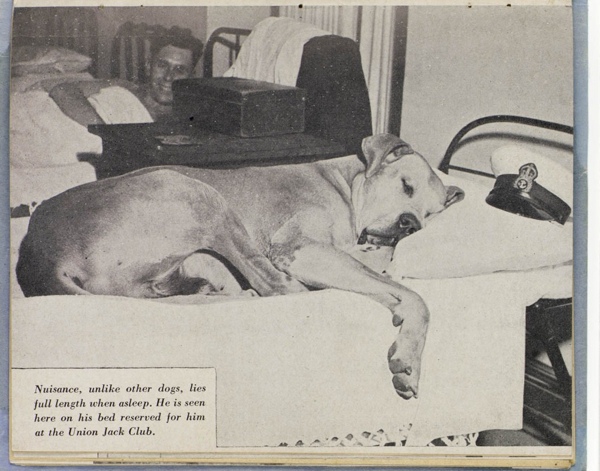
Ship’s dogs were fairly common—especially in the old days, when livestock was carried on board for food. A dog onboard could help keep the animals in check and rescue people who fell in the water, but was also a handy way to enhance crew morale. After all, even the grumpiest sailor grins at a wagging tail. But the dog is always just a dog, and never a full member of the crew.
That is, except for Nuisance. He was a South African Great Dane, who got his name as a pup by wagging his injured tail so enthusiastically that everyone was covered in blood spatters. Nuisance was a massive dog, at more than six and a half feet (two meters) standing up. He spent his time in Cape Town’s many dockyards and naval bases. He made friends with sailors, following them around and even joyriding trains with them. But since he was a dog and therefore couldn’t pay his fares, the railway company threatened to put him down. When the naval command heard about the popular dog’s peril, they had an idea: train rides were legally free for members of the Royal Navy.
Nuisance was enlisted on 25 August 1939 under the name of Just Nuisance. This made him the first and only canine Royal Navy member in history. Although he never technically went to sea, his naval service was a happy and eventful one. The dog was a well-liked and respected member of the force, performing various ceremonial functions, guarding sailors while they were ashore and even earning himself a promotion.
Although he eventually passed away, Just Nuisance remains in spirit: His statue guards his home port even today.

If Sefton was human, he’d constantly fall on his face due to the weight of all his medals. He spent seventeen years in active military service (an impressive career, considering that the average lifespan of a horse is around twenty-five to thirty years). He won prizes in show jumping and point-to-point races. He was one of the horses used in Buckingham Palace’s famed Changing of the Guard. He was the first ever British Horse of the Year, and has a wing named after him in the Royal Veterinary College.
That last accolade may have something to do with the IRA bomb he took in the face . . . and the fact that he survived.
While on their way to Buckingham Palace, Sefton’s formation was hit by a car-mounted nail bomb (a bomb packed with nails, razors, and other sharp objects to cause as much ugly damage as possible). A number of horses and riders were killed on the spot. Compared to Sefton, some would say they had it easy: the poor horse was riddled with thirty-four wounds, each of them likely fatal.
Amazingly, Sefton survived. Even a severed jugular vein couldn’t finish him off. He survived an incredibly difficult surgical operation, and eventually even returned to active service. There, he regularly passed the spot where his life had almost ended, presumably neighing defiance at death whenever he passed.
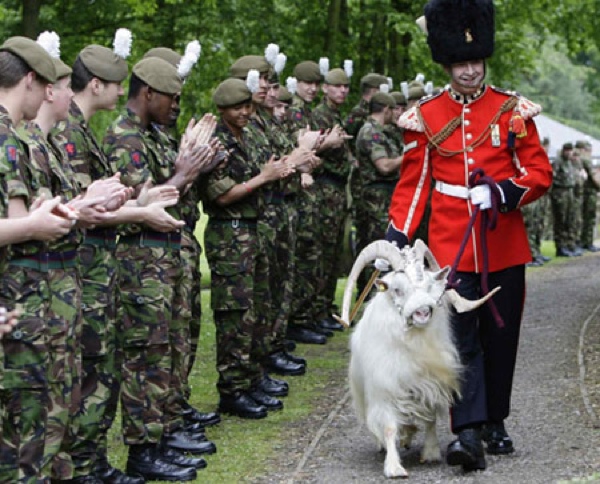
Despite sharing his name with a prince, William “Billy” Windsor is not related to British royalty. This is most likely a good thing, since he is a goat. The aptly nicknamed Billy was buddies with the Queen, though. In fact, she liked him enough to give him a job.
As per the Queen’s recommendation and historical tradition, Billy Windsor became a member of the “Royal Welsh” infantry battalion in the British Army. He was a salaried, ranking member of the unit: his Army number was 25232301 and his rank was lance corporal. He was also in charge of leading all of the unit’s parades. As special perks of the job, Billy received daily rations of Guinness (“to keep the iron up”) and two cigarettes a day (eating cigarettes is thought to be good for goats).
Billy retired with full honors after eight years of service at home and abroad. His resume was spotless, save for one little stain: at one point in his career, he was temporarily demoted to fusilier (essentially the unit’s version of a private) due to disorderly conduct: he had tried to headbutt a drummer, most shockingly at the Queen’s birthday parade.
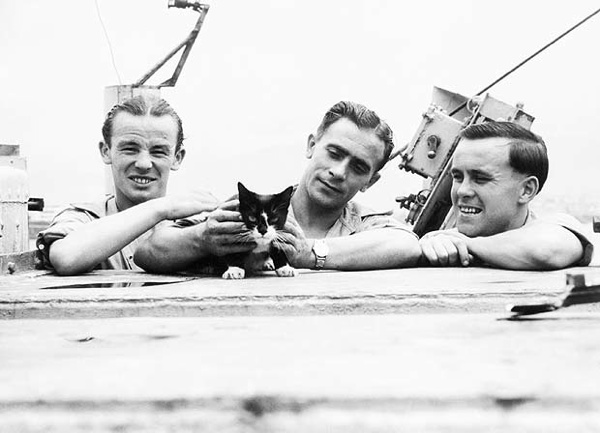
Found wandering around a Hong Kong dockyard in 1949, Simon the cat was taken in by the Royal Navy sloop HMS Amethyst. The friendly animal immediately won over the entire crew. Even the occasional sailor who found a gift of gutted rat in his bunk could bear no ill will to Simon.
Fate had dreary plans for Simon and HMS Amethyst. They became entangled in the Chinese Civil War, receiving heavy damage from communist weapons and ending up trapped on the Yangtze River for three months. Simon was badly wounded in the attack and was not expected to survive even one night. Meanwhile, the anchored ship was quickly being overrun by a terrible rat infestation. The rodents were tearing through their supplies and there was nothing to be done. HMS Amethyst would perish between communists and rats.
Which is when Simon made his return. Miraculously surviving his wounds (which were caused by mortar shells, by the way), the cat took one look at the situation. Then he grinned and leapt into action.
Simon the cat fought the rats tirelessly, week after week. His miracle survival boosted the crew’s morale, helping them to finally make their escape three months later. When the ship reached home, Simon became an instant celebrity. He was awarded a PDSA Dickin Medal (the animal equivalent of the Victoria Cross) and given the rank of “Able Seacat”. Sadly, he had been pushing himself too hard. His crew finally safe, Simon the cat didn’t have to fight anymore. He died in quarantine due to a virus brought on by his injuries.
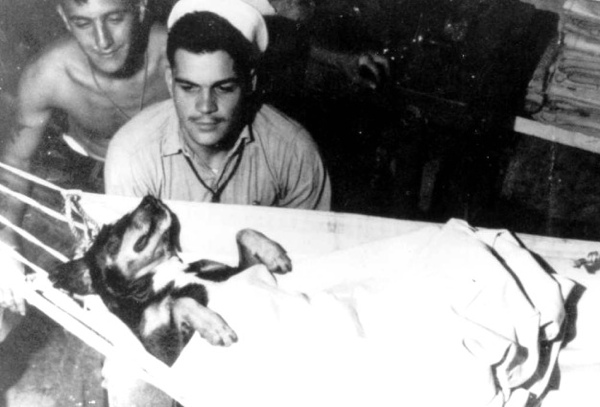 Sinbad the dog was originally intended to be a present for a sailor’s girlfriend. When the lady couldn’t take him in, Sinbad ended up staying aboard the sailor’s ship, USCGS George W. Campbell.
Sinbad the dog was originally intended to be a present for a sailor’s girlfriend. When the lady couldn’t take him in, Sinbad ended up staying aboard the sailor’s ship, USCGS George W. Campbell.
The young pup quickly adapted to his naval environment. He started drinking coffee and getting drunk on whiskey and beer with his crew (it was a different time). He held his own, assigned duty stations at both regular and general quarters of the ship. The latter means “battle stations”, by the way. So when the ship got ready to rumble, Sinbad was expected to be part of the proceedings.
Sinbad was an officially enlisted member of the crew, with a paw print signature on his enlistment papers. He had his own Red Cross and service ID, his own bunk, and even a service record. Being a dog with a penchant for whiskey, he had a tendency to get demoted and disciplined every once in a while. He was always able to climb back up, eventually settling for a special Chief Dog rank, which translated to the rank and rate of a Chief Petty Officer. Yes, the dog was a non-commissioned officer.
His tendency to visit port bars soon gained media attention and before he knew it, he was a public figure. His mixed breed background and happy-go-lucky ways resonated with the war-trodden masses and Sinbad became a national celebrity, often appearing in promotional pictures and newspaper stories. He happily abused this fact by causing all sorts of turmoil, up to and including international diplomatic incidents.
Sinbad saw plenty of combat action, especially against submarines. The public generally wasn’t informed that he spent a good chunk of said action sequestered below the decks and, on occasion, hung over. Still, he was considered a valuable member of his crew. He was awarded a total of six medals and his mere presence was thought to make the George W. Campbell unsinkable.
Eventually, Sinbad got old and retired honorably for a quiet life of bar-hopping and staring longingly at the sea. Even today, the ship’s current incarnation has a statue of Sinbad in its mess hall—just in case.
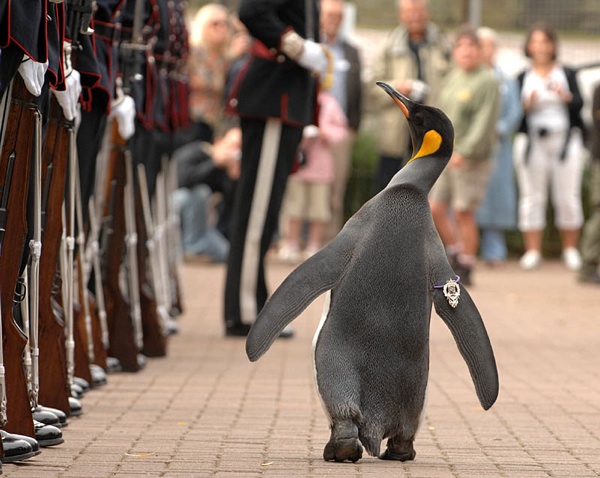
If you ever visit Edinburgh Zoo in Scotland, be prepared to salute the pool of king penguins, the second largest of kind of penguin. One of its inhabitants has been personally knighted by the King of Norway, who stated that the penguin is “in every way qualified to receive the honor and dignity of knighthood”.
The esteemed bird is called Nils Olav, and he also happens to be a high-ranking commander of the Norwegian Royal Guard. His official title is Colonel-in-Chief Sir Nils Olav, which would impress even the Pentagon.
The Royal Guard regularly attends the Edinburgh Military Tattoo (which is sadly not a tattoo convention, but a military orchestra and drill festival). On one trip, their lieutenant became fascinated with the zoo’s penguins and for some reason the unit decided to adopt one.
On every trip to Edinburgh, they went to greet their avian brother in arms. They promoted Nils Olav each time they saw him, and even the king got in on the action —until, one day, they noticed that his rank now technically surpasses pretty much everyone. Perhaps this is why Nils Olav is consistently referred to as a mere mascot in Norway. After all, no one wants a situation where they have to figure out how to obey a command that goes “Waark!”
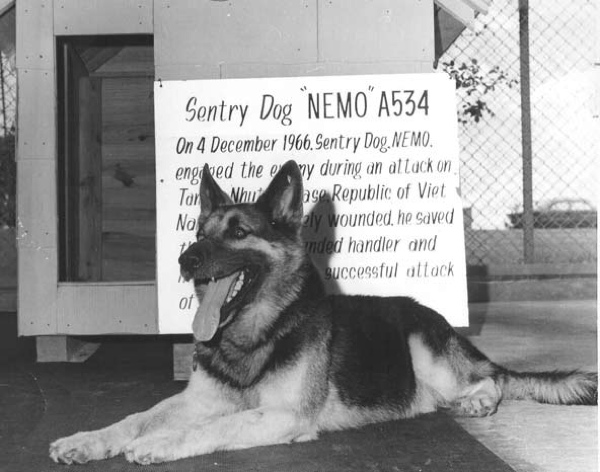
When you’re a German shepherd with a name that puts the Terminator to shame, a heroic military career is to be expected. Nemo A534 was aware of this—and delivered.
Sentry dogs were valuable in the Vietnam War. Their keen senses could notice the enemy far better than human soldiers. They were also useful in the event of an actual attack. A motivated war dog can mow down rows of creeping guerrillas that a human wouldn’t even notice before it’s too late.
On December 4, 1966, Nemo A534 became the king of all sentry dogs. On patrol, he and his handler spotted a group of hidden Viet Cong fighters possibly attempting a surprise attack. The ensuing fight caused two enemy casualties, but also severely wounded the handler. Nemo was also hurt: He lost an eye and took a bullet wound on the nose. This presented a problem. The backup would take a while to get there. The jungle was full of angry VC, and Nemo’s handler was unable to move.
The injured Nemo solved the problem by placing himself on top of his handler’s body and dealing out severe punishment to anyone approaching. It took a while for the backup to get there, but as much as they tried, the VC never had a chance to get at the handler. By the time Nemo’s own troops arrived, he was in such a battle mode that he had to be sedated by the company vet before they could get to treat the handler.
Nemo became instant hero and was given a permanent retirement kennel, a war dog version of a boat and a small island somewhere on the Pacific. Of course, this canine Chuck Norris didn’t just retire in peace. He continued working as a recruiting dog, presumably glowering at people with his one good eye until they were shamed into joining.
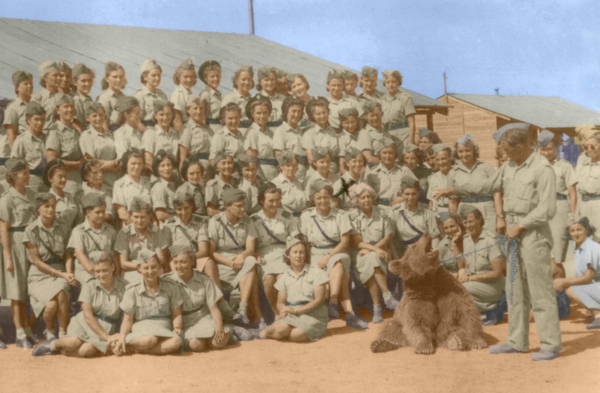
In 1943, a Polish artillery supply company found a small brown bear cub while fighting in the Middle East. Unwilling to leave the bear to die in the middle of Iranian wilderness, they adopted him and named him Wojtek. The bear enjoyed the company of other soldiers, and even playfully wrestled them on occasion. He could even perform a fairly convincing military salute. To fully prove that he was a natural back-line soldier, Wojtek even developed a taste for beer and cigarettes.
When the company was deployed to support the British in the Italian campaign, pets weren’t allowed on the transport ships. The Polish force cleverly got around this by officially enlisting Wojtek as a private. For the rest of the war, Private Wojtek traveled with the company. He slept in a specially constructed truck crate, or in the tents with other soldiers. Since the unit’s function was to provide munitions for the artillery, Wojtek could also do his share of combat. During the Battle of Monte Cassino, he carried munition along with his friends and never dropped a crate.
Wojtek the Soldier Bear survived the war and moved to the Edinburgh Zoo, which is apparently the go-to home for military animals of all countries. His legacy lives on in the official emblem of the Polish 22nd Transport Company: a bear carrying an artillery shell.
Pauli Poisuo also writes for Cracked.com. Why not follow him on Twitter?
